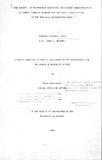| dc.description.abstract | The grazing behaviour and dietary characteristics of camels and
goats grazing together were studied on a 50 ha plot at Kibwezi Dryland
Field station in southeastern Kenya.Tree and shrub densities of woody
plants on the site were determined using the Point Centred Quarter Method
(PCQ). The production of the herbaceous plants was quantified in dry and
wet seasons by clipping all material within 0.25m2 quardrats, drying and
weighing it. Grazing behaviour was determined using focal observation
methods. Microhistological technique was used to determine the dietary
botanical composition of camel and goat diets.
Time spent feeding, walking, ruminating, resting and other activities
was influenced by both advancing plant maturity which spanned three
consecutive 16-day study periods and animal species. Camels spent less
time feeding than goats. For both species, feeding took place mainly in
the morning and late afternoon. At mid-day, the majority of animals
rested or ruminated. Time spent walking was affected by advance in plant
maturity in the case of camels alone. This increased from period one to
three. The two animal species, however, spent the same time walking in the
study. The distribution of walking over the observation day was similar to
that of feeding. Ruminating time was not affected by advance in plant
maturity for the two species. Camels ,however spent less time ruminating
than goats. Animals spent more time resting while standing than when
lying. Resting time decreased with advance in plant maturity for both
species. Camels, however, spent more time resting than goats. Likewise
time spent in other activities decreased with period.
Camel and goat diets were composed primarily of browse in the dry and
v
wet seasons.Its contribution to camel diets was 90.16 % and 93.99 % in the
dry and wet seasons, respectively. Its proportion in the goat diets was
77.30 % and 61.31 % in the dry and wet sesaons. Goats were more adept at
switching from one forage class to another than camels. The order in which
the camels and goats selected plants and their dietary overlap were
influenced by season.
Generally dry season plant samples were lower in crude protein (CP)
than the wet season samples. The fibre and lignin content of dry season
samples was higher than in the wet season samples. Consequently diets
selected by camels and goats in the dry season were lower in quality than
their wet season diets. Browse was of higher nutritional value than grass
in both seasons as most browse species contained higher crude protein
(CP), cell solubles (CS) and were more digestible than grass species.
Overall, camels and goats met their nutritional requirements in both dry
and wet seasons. However, they did not associate preference with
nutritional variables of plants such as crude protein (CP), acid detergent
fibre (ADF), and dry matter digestibility (DMD), especially in the dry
season. These findings form a guideline for range managers in assessing
the usefulness of the vegetation resource to camels and goats and how the
two species exploit the resource. | en |

